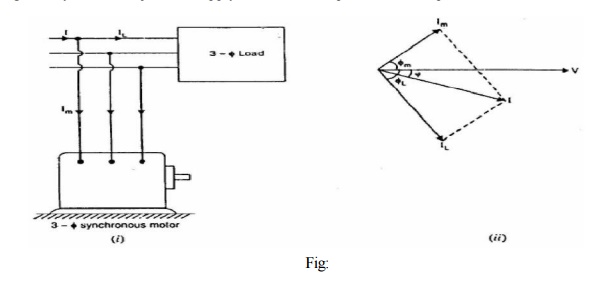Chapter: Electrical machines : Synchronous Motors
Synchronous Condenser and its Advantages, Disadvantages
Synchronous Condenser
A synchronous motor takes a leading current when over-excited and, therefore, behaves as a capacitor. An over-excited synchronous motor running on no-load in known as synchronous condenser. When such a machine is connected in parallel with induction motors or other devices that operate at low lagging power factor, the leading kVAR supplied by the synchronous condenser partly neutralizes the lagging reactive kVAR of the loads. Consequently, the power factor of the system is improved. Fig: 2.29 shows the power factor improvement by synchronous condenser method. The 3 - f load takes current IL at low lagging power factor cosфL. The synchronous condenser takes a current Im which leads the voltage by an angle fm. The resultant current I is the vector sum of Im and IL and lags behind the voltage by an angle ф. It is clear that ф is less than фL so that cos f is greater than cos фL. Thus the power factor is increased from cos фL to cos ф. Synchronous condensers are generally used at major bulk supply substations for power factor improvement.

Advantages
(i) By varying the field excitation, the magnitude of current drawn by the motor can be changed by any amount. This helps in achieving step less control of power factor.
(ii) The motor windings have high thermal stability to short circuit currents.
(iii) The faults can be removed easily.
Disadvantages
(i) There are considerable losses in the motor.
(ii) The maintenance cost is high.
(iii) It produces noise.
(iv) Except in sizes above 500 RVA, the cost is greater than that of static capacitors of the same rating.
(v) As a synchronous motor has no self-starting torque, then-fore, an auxiliary equipment has to be provided for this purpose.
Related Topics